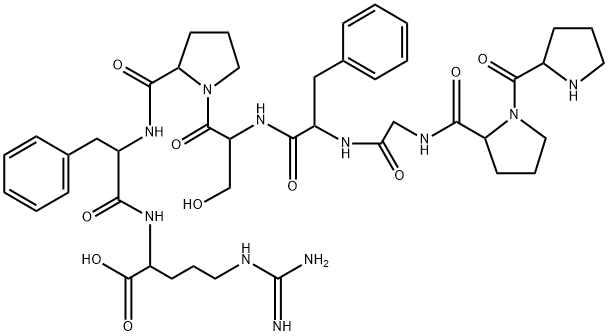Bradykinin (2-9)

Bradykinin (2-9) 性质
| 密度 | 1.46±0.1 g/cm3(Predicted) |
|---|---|
| 储存条件 | −20°C |
| 溶解度 | 溶于二甲基亚砜 |
| 酸度系数(pKa) | 3.34±0.10(Predicted) |
| 形态 | 白色至类白色粉末。 |
| 颜色 | 白色至米白色 |
| 序列 | -Pro-Pro-Gly-Phe-Ser-Pro-Phe-Arg-OH |
Bradykinin (2-9) 用途与合成方法
The Bradykinin peptide system is a tissue-based system with potent cardiovascular and renal effects. To investigate the regulation of this system, a highly sensitive amino terminal-directed radioimmunoassay that, with high performance liquid chromatography, enables the measurement of Bradykinin-(1-7), Bradykinin-(1-8), and Bradykinin-(1-9), is developed. Together with a carboxy terminal-directed radioimmunoassay, Bradykinin peptides in rat kidney and blood are characterized. The predominant Bradykinin peptides in kidney are Bradykinin-(1-9) (~100 fmol/g wet weight of tissue) and Bradykinin-(1-7) (~70 fmol/g), with low levels of Bradykinin-(1-8) (~8 fmol/g) and Bradykinin-(4-9) (~12 fmol/g) detectable; Bradykinin-(2-9) and Bradykinin-(3-9) are below the limits of detection. In blood, the levels of Bradykinin-(1-9) are very low (~2 fmol/ml), and other Bradykinin peptides are below the limits ofdetection. Administration of the angiotensin converting enzyme (ACE) inhibitor Perindopril is associated with an approximate twofold increase in renal levels of Bradykinin-(1-8) and Bradykinin-(1-9) and a decrease in the Bradykinin-(1-7)/Bradykinin-(1-9) ratio. The amino terminal-directed radioimmunoassay is also applied to heart, aorta, brown adipose tissue, adrenal, lung, and brain. For these tissues, Bradykinin-(1-7) and Bradykinin-(1-9) are of similar abundance (16-340 fmol/g), with lower levels of Bradykinin-(1-8).
纯度(HPLC) ≥98.0%
醋酸根含量≤12.0%
水分含量≤8.0%
肽含量≥80.0%
内毒素≤50EU/mg
氨基酸组成分析≤±10%
Bradykinin (2-9) 价格(试剂级)
| 更新日期 | 产品编号 | 产品名称 | CAS号 | 包装 | 价格 |
|---|---|---|---|---|---|
| 2025-02-08 | HY-P1490 | 16875-11-9 | 1 mg | 457 | |
| 2025-02-08 | HY-P1490 | PRO-PRO-GLY-PHE-SER-PRO-PHE-ARG | 16875-11-9 | 5mg | 780 |

